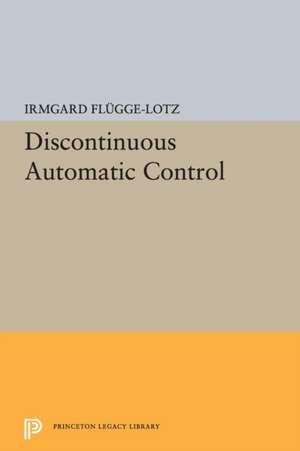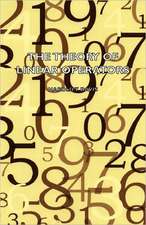Discontinuous Automatic Control: Princeton Legacy Library
Autor Irmgard Flugge–lotzen Limba Engleză Paperback – 11 feb 2016
| Toate formatele și edițiile | Preț | Express |
|---|---|---|
| Paperback (1) | 270.36 lei 6-8 săpt. | |
| Princeton University Press – 11 feb 2016 | 270.36 lei 6-8 săpt. | |
| Hardback (1) | 569.67 lei 6-8 săpt. | |
| Princeton University Press – 18 apr 2016 | 569.67 lei 6-8 săpt. |
Din seria Princeton Legacy Library
-
 Preț: 437.79 lei
Preț: 437.79 lei -
 Preț: 172.27 lei
Preț: 172.27 lei - 16%
 Preț: 683.63 lei
Preț: 683.63 lei - 16%
 Preț: 2324.11 lei
Preț: 2324.11 lei -
 Preț: 376.99 lei
Preț: 376.99 lei - 23%
 Preț: 780.26 lei
Preț: 780.26 lei -
 Preț: 377.31 lei
Preț: 377.31 lei -
 Preț: 313.18 lei
Preț: 313.18 lei - 16%
 Preț: 882.80 lei
Preț: 882.80 lei - 16%
 Preț: 736.40 lei
Preț: 736.40 lei - 16%
 Preț: 860.09 lei
Preț: 860.09 lei -
 Preț: 362.12 lei
Preț: 362.12 lei -
 Preț: 223.24 lei
Preț: 223.24 lei -
 Preț: 363.10 lei
Preț: 363.10 lei - 16%
 Preț: 915.48 lei
Preț: 915.48 lei -
 Preț: 340.22 lei
Preț: 340.22 lei - 16%
 Preț: 835.12 lei
Preț: 835.12 lei -
 Preț: 266.84 lei
Preț: 266.84 lei -
 Preț: 317.65 lei
Preț: 317.65 lei -
 Preț: 329.09 lei
Preț: 329.09 lei -
 Preț: 265.73 lei
Preț: 265.73 lei -
 Preț: 260.54 lei
Preț: 260.54 lei -
 Preț: 314.84 lei
Preț: 314.84 lei -
 Preț: 402.66 lei
Preț: 402.66 lei -
 Preț: 464.18 lei
Preț: 464.18 lei -
 Preț: 351.09 lei
Preț: 351.09 lei -
 Preț: 483.81 lei
Preț: 483.81 lei - 19%
 Preț: 500.29 lei
Preț: 500.29 lei -
 Preț: 388.44 lei
Preț: 388.44 lei -
 Preț: 328.48 lei
Preț: 328.48 lei - 23%
 Preț: 742.04 lei
Preț: 742.04 lei -
 Preț: 372.92 lei
Preț: 372.92 lei -
 Preț: 328.70 lei
Preț: 328.70 lei - 19%
 Preț: 505.89 lei
Preț: 505.89 lei -
 Preț: 446.25 lei
Preț: 446.25 lei -
 Preț: 289.17 lei
Preț: 289.17 lei - 19%
 Preț: 575.53 lei
Preț: 575.53 lei -
 Preț: 447.20 lei
Preț: 447.20 lei -
 Preț: 484.19 lei
Preț: 484.19 lei -
 Preț: 271.12 lei
Preț: 271.12 lei -
 Preț: 314.46 lei
Preț: 314.46 lei -
 Preț: 362.51 lei
Preț: 362.51 lei -
 Preț: 307.07 lei
Preț: 307.07 lei - 19%
 Preț: 498.46 lei
Preț: 498.46 lei -
 Preț: 272.27 lei
Preț: 272.27 lei - 19%
 Preț: 458.44 lei
Preț: 458.44 lei -
 Preț: 406.20 lei
Preț: 406.20 lei - 19%
 Preț: 515.73 lei
Preț: 515.73 lei -
 Preț: 428.88 lei
Preț: 428.88 lei -
 Preț: 369.27 lei
Preț: 369.27 lei
Preț: 270.36 lei
Nou
Puncte Express: 406
Preț estimativ în valută:
51.74€ • 55.32$ • 43.13£
51.74€ • 55.32$ • 43.13£
Carte tipărită la comandă
Livrare economică 17 aprilie-01 mai
Preluare comenzi: 021 569.72.76
Specificații
ISBN-13: 9780691627182
ISBN-10: 0691627185
Pagini: 178
Dimensiuni: 155 x 232 x 15 mm
Greutate: 0.26 kg
Editura: Princeton University Press
Seria Princeton Legacy Library
ISBN-10: 0691627185
Pagini: 178
Dimensiuni: 155 x 232 x 15 mm
Greutate: 0.26 kg
Editura: Princeton University Press
Seria Princeton Legacy Library
Descriere
Descriere de la o altă ediție sau format:
Discontinuously working elements (on-off controls) are widely used in automatic control systems. From an engineering point of view they are attractive because they are nearly always Simpler, more rugged, and cheaper to build than continuous controls. But prediction of their effects in the controlled system is sometimes so complicated that engineers
Discontinuously working elements (on-off controls) are widely used in automatic control systems. From an engineering point of view they are attractive because they are nearly always Simpler, more rugged, and cheaper to build than continuous controls. But prediction of their effects in the controlled system is sometimes so complicated that engineers



















